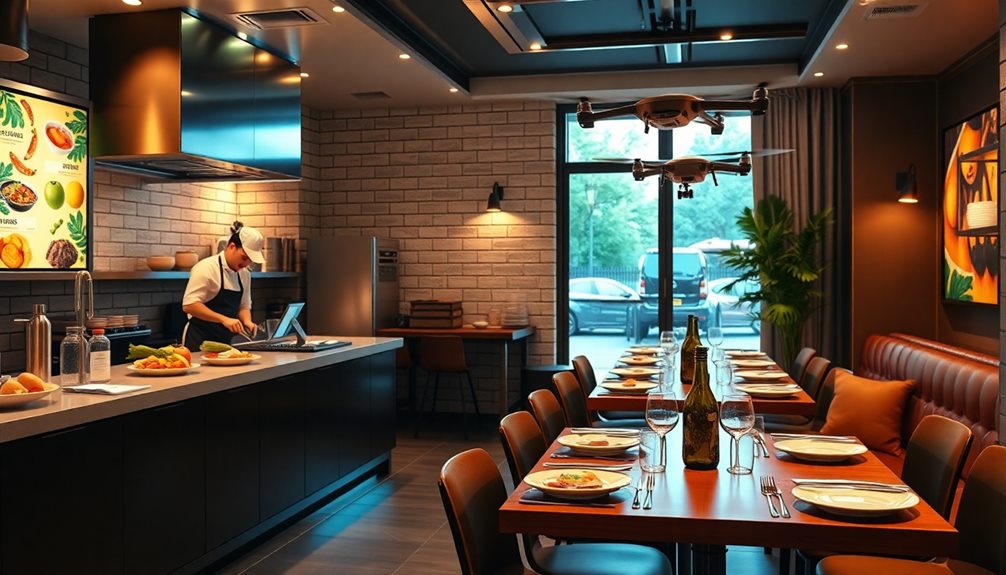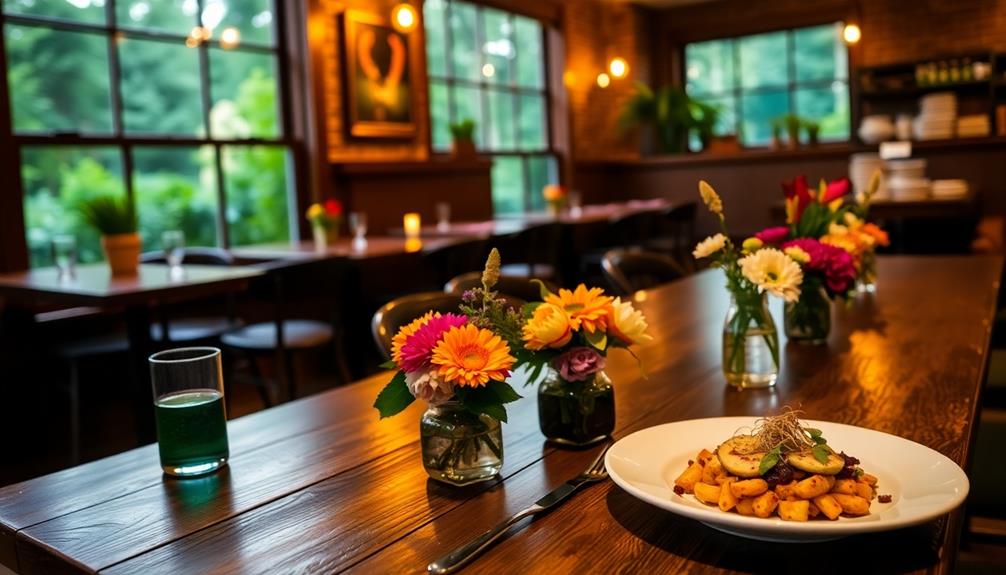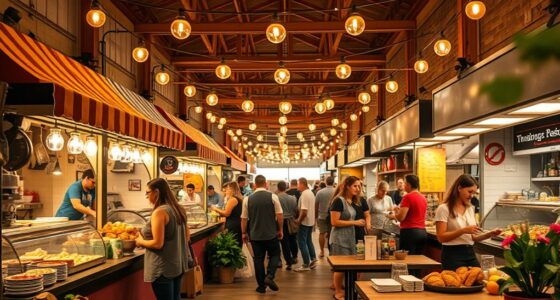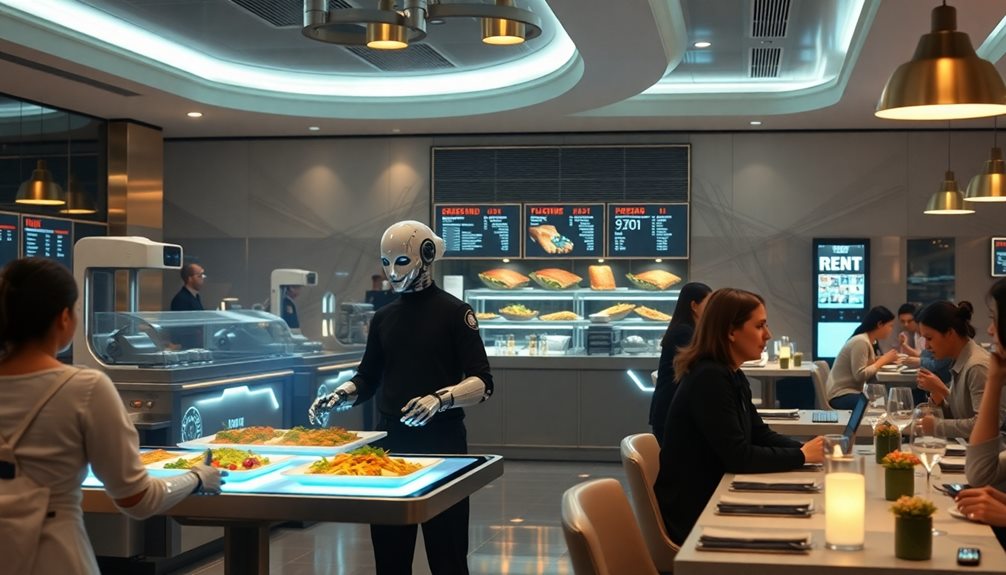Virtual restaurant concepts revolutionize dining by operating exclusively as delivery-only services, often from ghost kitchens. You'll find a diverse menu that adapts quickly to trends, all while avoiding the high overhead costs associated with traditional restaurants. These models capitalize on technology for efficient order management and seamless customer interaction. With the market projected to reach $1 trillion by 2030, the potential for growth is immense. By understanding how these brands launch and market their offerings, you'll gain insight into this exciting culinary landscape and uncover more strategies to thrive in the competitive food service industry.
Key Takeaways
- Virtual restaurants operate as delivery-only options, utilizing ghost kitchens to reduce overhead costs and financial risks.
- Menu flexibility allows virtual brands to quickly adapt to consumer preferences and market trends, launching multiple concepts from a single kitchen.
- Technology streamlines operations, enhancing customer experiences and optimizing menu offerings through data-driven insights and order management systems.
- Successful examples like MrBeast Burger and Pardon My Cheesesteak demonstrate the potential of engaging existing fan bases and leveraging social media for visibility.
- The industry is projected to reach a $1 trillion valuation by 2030, driven by innovation, niche markets, and sustainable practices.
Overview of Virtual Restaurants
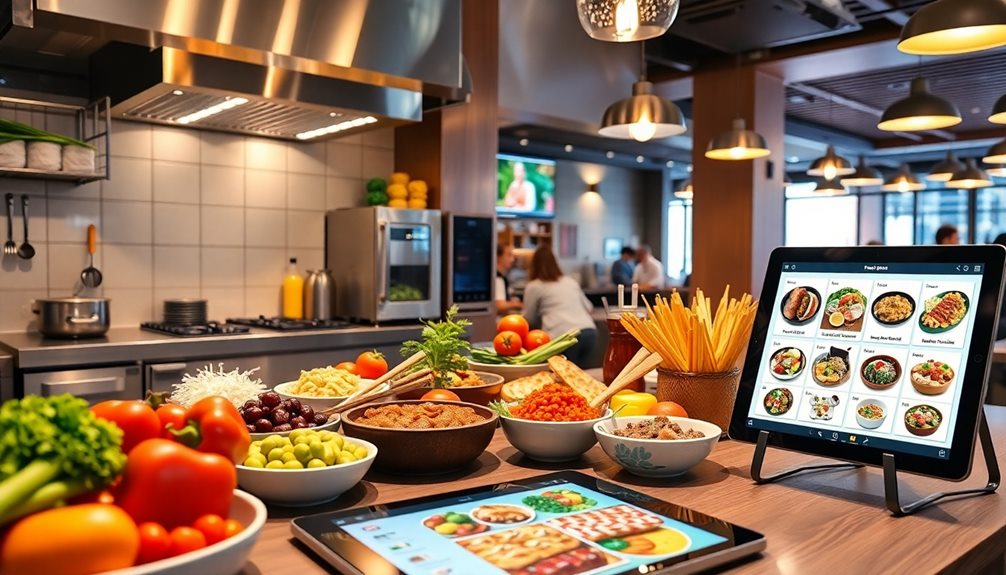
When you think about dining, virtual restaurants mightn't be the first thing that comes to mind, but they're reshaping the way we enjoy food. These innovative establishments operate solely as delivery-only options, often launching through existing restaurants or ghost kitchens. By eliminating the need for a physical dining space, they considerably reduce overhead costs, allowing culinary entrepreneurs to enter the market with lower financial risk.
The global demand for virtual restaurant services is skyrocketing, with projections estimating 185 million users by 2025. This shift highlights your growing preference for high-quality food delivery options. Virtual restaurants offer remarkable flexibility, enabling brands to test various cuisines and adapt their menus based on real-time customer feedback, a feat traditional restaurants struggle to achieve.
Since their inception, virtual restaurants have gained immense popularity, processing over 20 million orders globally and contributing to cumulative sales exceeding $400 million. This rise is largely driven by the pandemic, which fueled a surge in delivery demand.
With their cost-effective model and flexibility, virtual restaurants are redefining your dining experience and setting the stage for the future of food delivery.
Benefits of Virtual Brands

When you explore virtual brands, you'll quickly notice their cost efficiency and menu flexibility.
By leveraging existing kitchen operations, you can boost revenue without major disruptions.
Plus, the ability to adapt your menu based on customer preferences allows you to stay competitive in a rapidly changing market.
Cost Efficiency
Cost efficiency is a key advantage of virtual restaurant concepts, allowing existing eateries to capitalize on their underutilized kitchen space. By leveraging virtual kitchens, restaurants can operate with minimal overhead costs, eliminating the need for a physical dining area. This means you can generate additional revenue without the burden of high rent or front-of-house staff expenses.
With a delivery-only model, you can quickly adapt to changing consumer preferences while maintaining low capital investments. This flexibility enables you to test various menu items and cuisines without the constraints of a traditional setup.
Plus, it leads to reduced food waste and optimized inventory management, which further enhances your bottom line.
Partnering with third-party delivery services expands your reach to a broader customer base, allowing for scalability without the financial risks of opening new locations.
Additionally, using data-driven insights from digital platforms helps you maximize kitchen efficiency, enhancing operational effectiveness. You can make informed decisions that boost profitability, ensuring your virtual brand thrives in a competitive market.
Embracing cost efficiency in this way positions you for success in the evolving landscape of the restaurant industry.
Menu Flexibility
In today's fast-paced food landscape, virtual brands thrive on menu flexibility, allowing operators to quickly adapt to consumer tastes and market trends. This flexibility means you can test and iterate on various cuisines without the limitations of a physical dining space. By leveraging data-driven decisions, you'll reduce food waste and optimize your offerings.
Without a traditional storefront, your virtual restaurant can pivot its menu based on current consumer demand and emerging trends. This responsiveness not only enhances customer satisfaction but also fosters greater engagement.
Additionally, you can launch multiple virtual brands from a single kitchen, maximizing your existing equipment while catering to diverse customer preferences.
Real-time adjustments based on sales data and customer feedback keep your virtual brands relevant and competitive. You can create limited-time menu items or seasonal offerings, generating excitement and urgency that drives sales.
This sense of exclusivity not only attracts new customers but also keeps your loyal patrons coming back for more. With menu flexibility at the core of your virtual restaurant strategy, you'll be well-equipped to thrive in an ever-evolving market.
Technology in Virtual Dining
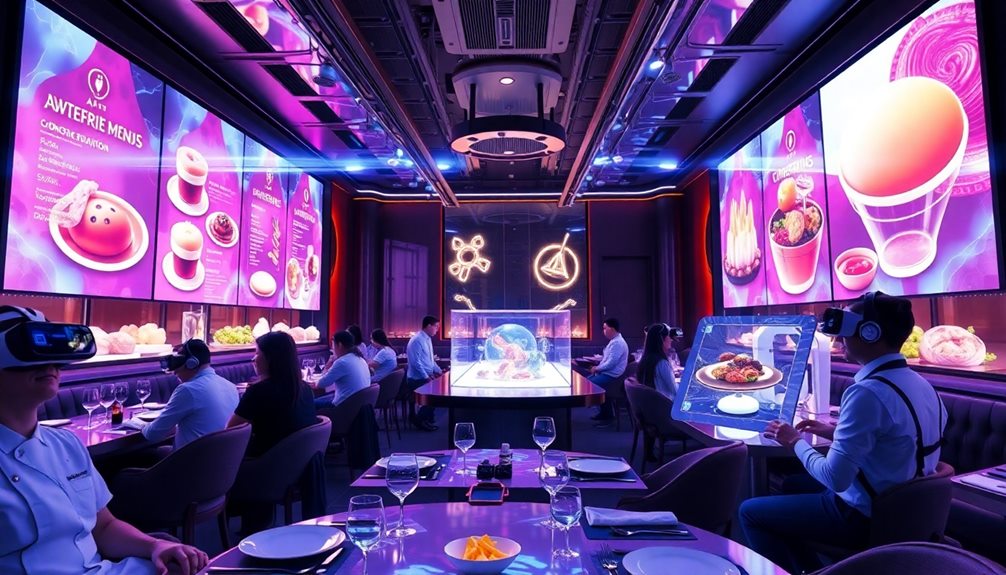
Technology plays an essential role in the success of virtual dining, often transforming how restaurants operate. By leveraging technology-driven solutions, virtual restaurants streamline operations through digital platforms that simplify management and integration of delivery-only brands. This adaptation allows you to maximize kitchen efficiency and optimize your menu offerings based on real-time performance tracking.
Here's a quick overview of how technology impacts virtual dining:
| Aspect | Benefit | Example |
|---|---|---|
| Order Management | Seamless customer interaction | Third-party delivery platforms |
| Kitchen Efficiency | Optimized menu offerings | Data-driven insights |
| User Interface | Easy navigation for operators | User-friendly management tools |
With advancements like AI integration, you can improve personalized customer experiences and operational efficiency. This not only enhances your market reach but also drives future growth in the virtual restaurant industry. Embracing these technological innovations is crucial for staying competitive and ensuring that your virtual dining concept thrives in a rapidly evolving marketplace.
Case Studies of Success
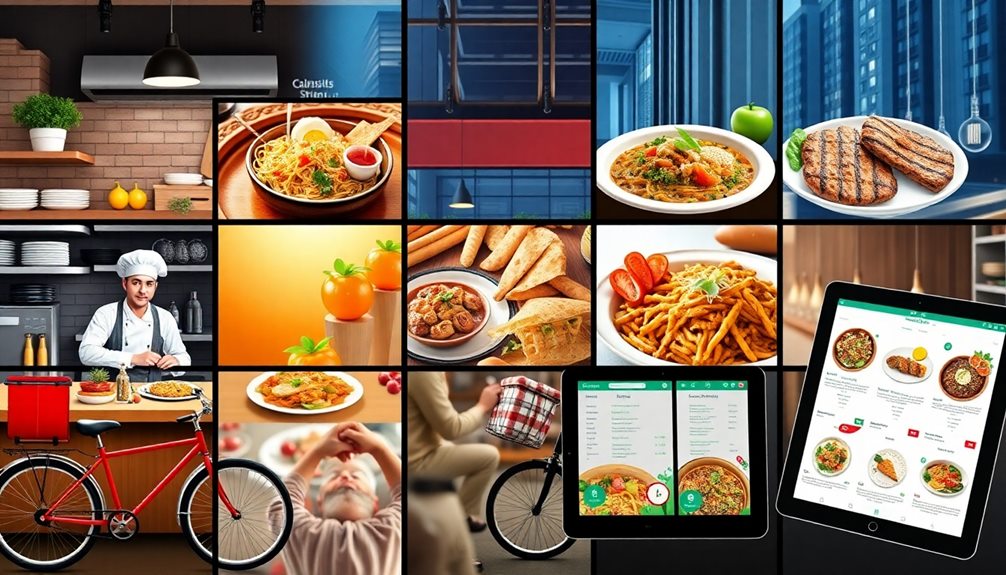
As virtual dining continues to evolve, several case studies highlight how innovative concepts can thrive in this competitive landscape.
Take MrBeast Burger, for example. By leveraging the massive online presence of YouTube star MrBeast, this virtual restaurant has tapped into millions of loyal followers, driving sales from participating kitchens and creating a unique dining experience.
Similarly, Pardon My Cheesesteak merges food and comedy, capitalizing on the popularity of the podcast "Pardon My Take." With a menu focused on cheesesteaks and loaded fries, it's attracted millions of weekly listeners, proving that a brand can benefit from the synergy of entertainment and culinary delights.
Another success story is Buddy Vs Cake Slice, led by celebrity chef Buddy Valastro. His reality TV fame draws dessert lovers in with a diverse menu of cakes for various occasions, showcasing the power of celebrity influence in the virtual restaurant space.
Key Statistics and Insights
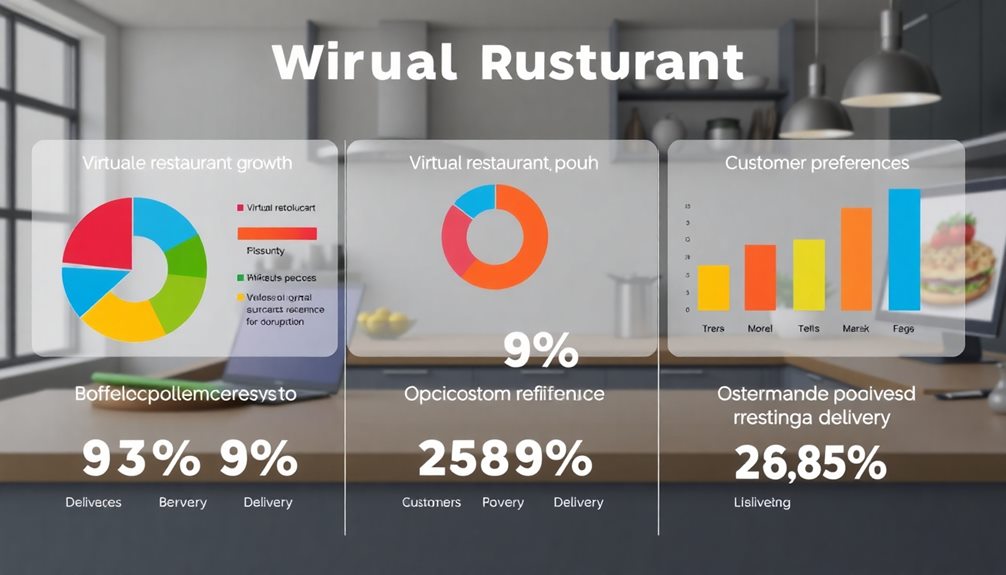
You might be surprised to learn that over 20 million orders have been served globally, underscoring the strong demand for virtual restaurants.
With more than 4,500 establishments generating over $400 million in sales, this sector is clearly making an impact.
As consumer preferences shift, the market is set to grow, projecting 185 million users by 2025.
Global Order Metrics
The virtual restaurant landscape has surged, with over 20 million orders served globally, underscoring the skyrocketing demand for delivery-only dining options. This growth reflects the increasing consumer preference for convenience and variety in food delivery.
Virtual Dining Concepts has established more than 4,500 virtual restaurants, showcasing how scalable this model can be in meeting diverse culinary cravings without the constraints of traditional dining.
Cumulatively, these operations have surpassed $400 million in sales, indicating significant revenue potential within the virtual restaurant industry. With a presence in 18 countries, virtual restaurants have proven their international appeal, adapting to various market needs and culinary tastes. This adaptability makes them a viable option for consumers seeking unique dining experiences from the comfort of their homes.
Moreover, partnerships with over 3,000 restaurants and 40 enterprise clients highlight the collaborative nature of the virtual dining model. These collaborations not only enhance brand visibility but also guarantee consumers have access to a wide range of food delivery options.
As you explore these metrics, it's clear that the virtual restaurant sector is a dynamic and rapidly evolving space, ripe with opportunities for growth and innovation.
Financial Growth Impact
Financial growth in the virtual restaurant industry is nothing short of remarkable. You'll find that virtual dining concepts have served over 20 million orders globally, showcasing significant consumer demand for delivery-focused models.
Cumulative sales from established virtual restaurants have surpassed $400 million, indicating robust revenue potential within this sector.
The rapid expansion has led to more than 4,500 virtual restaurants operating across 18 countries, reflecting a growing market presence. This isn't just a trend; it's a transformation in how food service operates.
You can also see that partnerships with over 3,000 restaurants and 40 enterprise clients highlight the collaborative opportunities available for financial growth in this space.
Looking ahead, the virtual restaurant industry is projected to reach a staggering valuation of $1 trillion by 2030. This potential underscores the lucrative nature of virtual dining and its importance in the broader food service market.
If you're considering entering this sector, the statistics clearly show that the financial growth opportunities are vast, making it an enticing option for both entrepreneurs and investors alike.
Steps to Launch a Virtual Concept
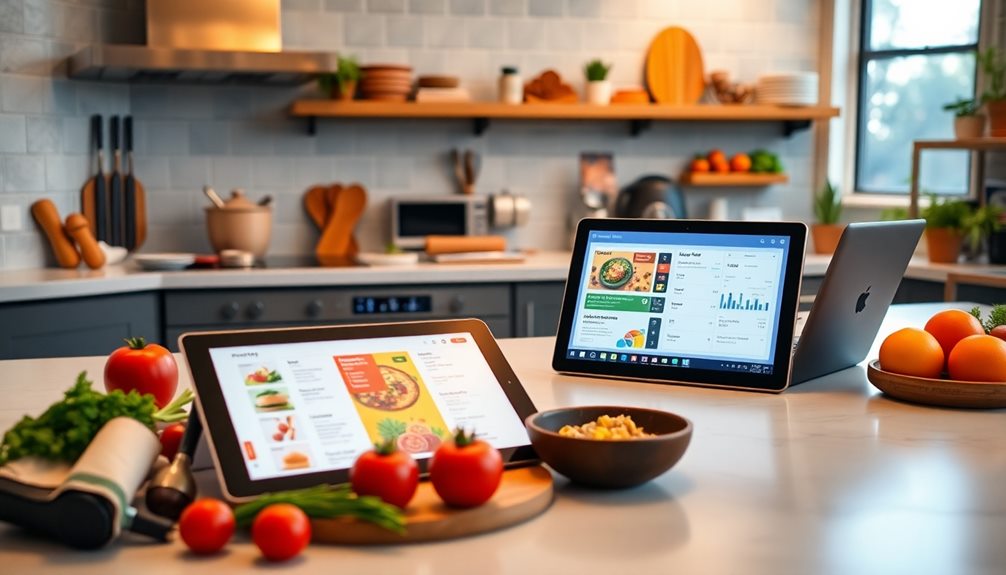
Launching a virtual restaurant concept requires careful planning and execution to assure success. Start by creating a strong menu that aligns with your brand identity. Focus on items that travel well, catering to your target audience's preferences.
Next, identify your target audience through market research. This will help you tailor your offerings and marketing strategies.
Then, organize your kitchen space effectively. Ascertain your existing equipment can handle increased production demands, or consider using ghost kitchens for flexibility and scalability.
Here's a quick overview of the steps:
| Step | Description |
|---|---|
| Menu Creation | Design a transportable menu that reflects your brand identity. |
| Market Research | Identify and understand your target audience's preferences. |
| Kitchen Organization | Optimize kitchen space and consider ghost kitchens if needed. |
| Online Presence | Build a cohesive brand online with engaging social media content. |
| Operations Refinement | Streamline processes and implement quality control measures. |
Marketing Strategies for Virtual Restaurants
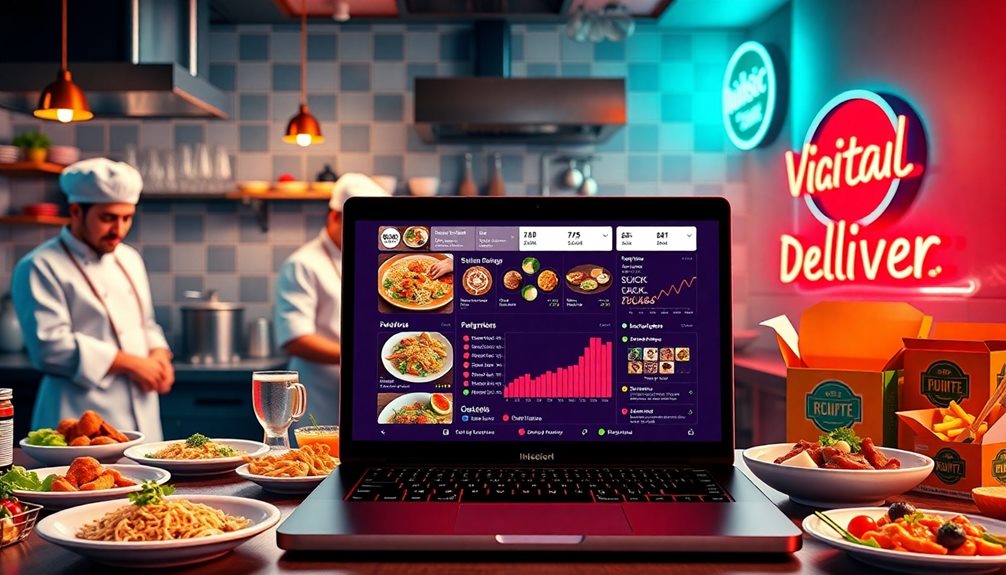
After establishing a solid foundation for your virtual restaurant, it's time to focus on how to attract and retain customers. Effective marketing strategies are essential for your virtual brand's success.
Start by leveraging social media platforms with visually appealing content that showcases your menu items. Partnering with influencers can amplify your brand visibility and engage a broader audience.
Consider implementing time-limited promotions, like launch-day discounts or buy-one-get-one (BOGO) deals, to create urgency and encourage immediate purchases from new customers.
Using third-party delivery services streamlines order management, enhancing customer interaction and ensuring a seamless experience that fosters repeat business.
Don't forget to track consumer behavior through data analytics. This insight allows you to optimize your marketing strategies, tailoring your offerings based on customer preferences and feedback, improving operational efficiency.
Challenges and Considerations
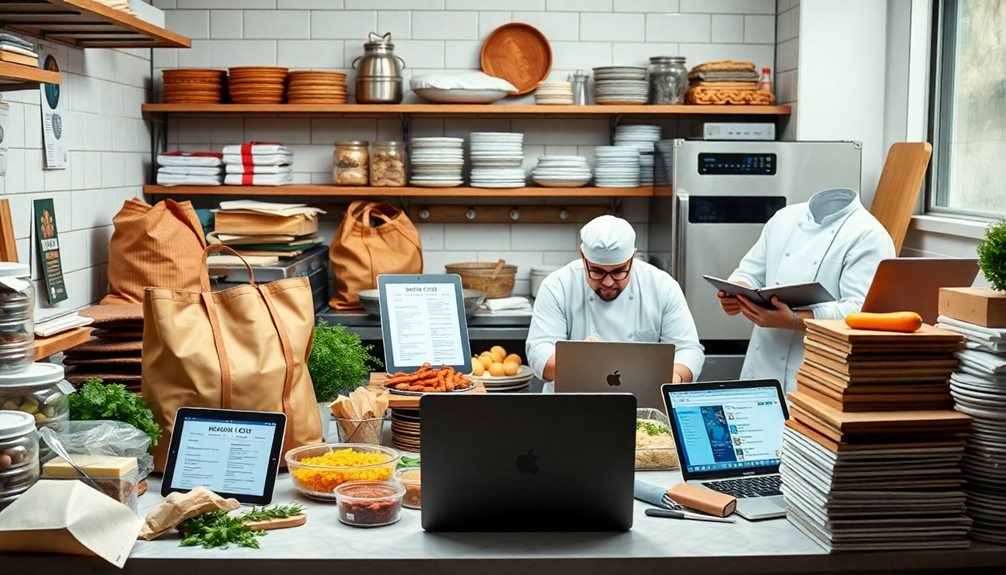
Maneuvering the virtual restaurant landscape often presents a unique set of challenges that can impact your success. From high commission fees to quality control issues, it's crucial to understand these hurdles.
| Challenge | Impact on Business | Solution |
|---|---|---|
| High Commission Fees | Up to 30% cuts into profitability | Negotiate terms or use multiple platforms |
| Building Brand Recognition | Difficult for new concepts to stand out | Invest in targeted marketing |
| Quality Control Issues | Inconsistencies in food quality | Implement strict kitchen protocols |
| Limited Guest Data | Hinders customer relationship building | Use integrated systems for insights |
| High Competition | Requires innovation to maintain loyalty | Optimize menu and marketing strategies |
Quality control issues arise when shared kitchen staff juggle multiple virtual dining concepts, leading to potential inconsistencies in your offerings. Additionally, limited access to guest data can stifle your ability to tailor experiences and build loyalty. The high competition in the delivery market means you'll need innovative marketing strategies and menu optimization to differentiate your brand. By acknowledging these challenges, you can develop effective solutions that foster your virtual restaurant's growth and sustainability.
Future Trends in Virtual Dining
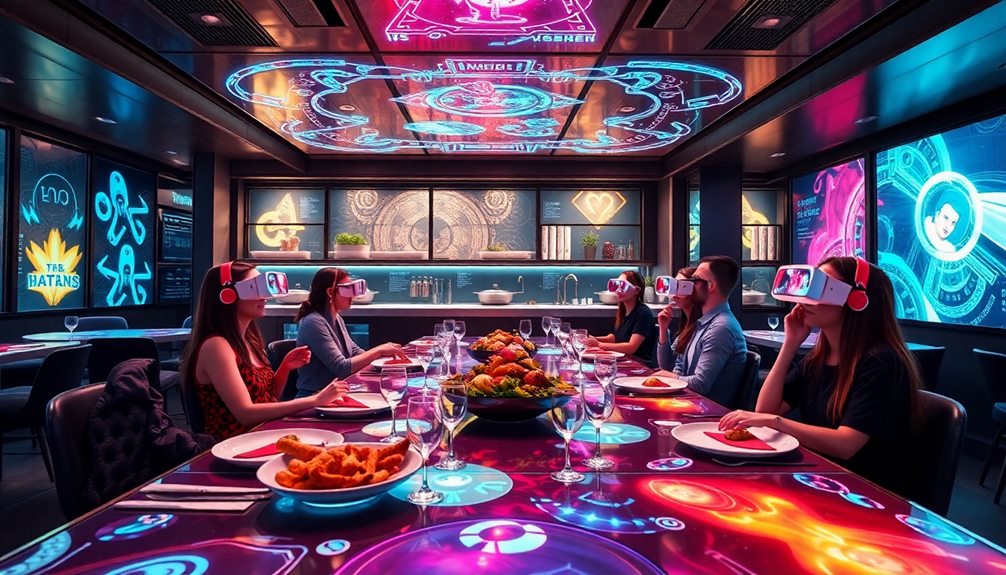
As you navigate the challenges of the virtual restaurant landscape, it's clear that the future holds exciting possibilities. The virtual restaurant industry is set to explode, with projections estimating it'll reach a $1 trillion market by 2030. This growth reflects an increasing consumer demand for delivery-focused dining options.
Additionally, leveraging AI in Business can enhance operational efficiency and customer engagement in virtual dining, leading to a more streamlined experience for both restaurants and patrons.
Future trends will likely include advancements in technology, like AI and data analytics, which will enhance order management and customer engagement. You'll find that these tools enable more personalized dining experiences, making it easier to cater to individual tastes.
Sustainability is another significant trend. As consumers prioritize eco-friendly practices, integrating sustainable packaging and environmentally responsible methods will become essential for your virtual restaurant.
Plus, expect niche markets and specialized cuisines to thrive, as diners seek unique culinary adventures.
Lastly, adapting continuously based on guest feedback and data insights will be vital for staying competitive. By focusing on these future trends, you can foster customer loyalty in an ever-evolving virtual dining landscape, ensuring your restaurant remains relevant and appealing to your audience.
Frequently Asked Questions
Who Owns Virtual Dining Concepts LLC?
You'll find that Virtual Dining Concepts LLC was co-founded by Robert Earl, Robbie Earl, and Trish Giordano in 2020. Robert Earl initially served as CEO, with Stephanie Sollers taking over in 2022.
How Do Virtual Dining Concepts Work?
You leverage existing kitchen spaces to create delivery-only brands, cutting overhead costs. By using technology for real-time insights, you optimize operations and adapt offerings based on performance, boosting sales from day one.
What Is Mrbeast's Virtual Restaurant?
MrBeast's virtual restaurant offers a unique dining experience, featuring delicious burgers, exciting sides, and convenient delivery. You order online, enjoy tasty meals, and connect with his massive fanbase, all from the comfort of home.
What Is the Ghost Kitchen Concept?
A ghost kitchen operates as a delivery-only restaurant without a storefront. You benefit from reduced overhead costs, allowing you to experiment with different culinary ideas while serving multiple brands from one location efficiently.
Conclusion
To sum up, virtual restaurant concepts are revolutionizing the dining experience, combining convenience with creativity. With 60% of consumers open to trying new virtual brands, the potential for success is huge. By leveraging technology and innovative marketing strategies, you can tap into this growing market. As you consider launching your own virtual concept, remember that adaptability and understanding consumer preferences are key to thriving in this dynamic landscape. Embrace the future of dining!
